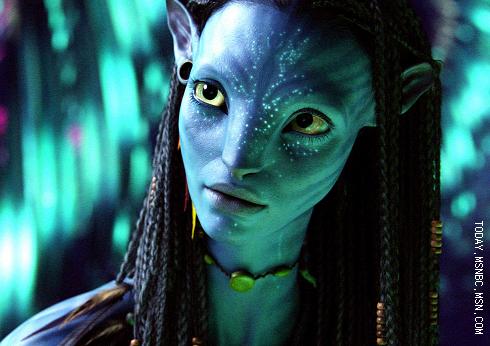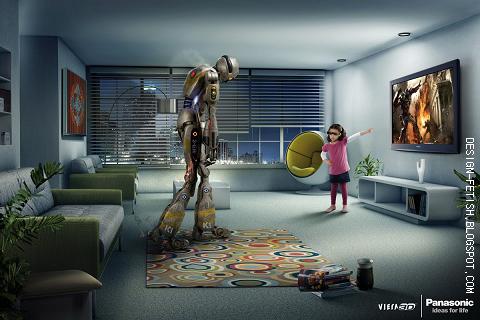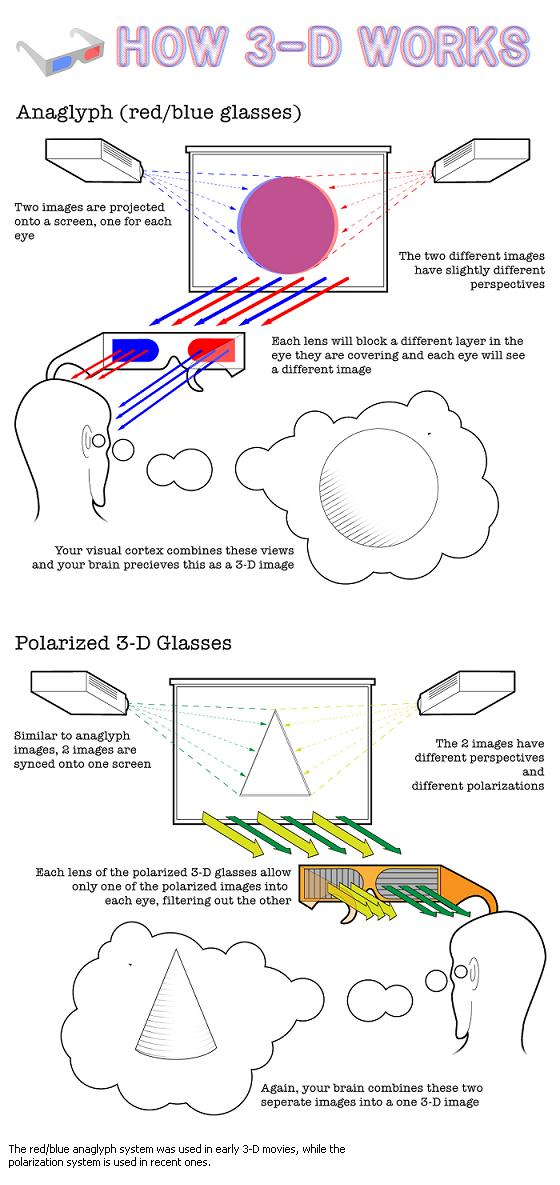The visual industry moves on to the next dimension
 |
ALTHOUGH THE astonishingly real scenes in the film Avatar were made possible by today’s cutting-edge technology, 3-D films are hardly a recent invention. In fact, they are almost as old as motion pictures. The fad came in cycles: The interest in 3-D films flamed up only to quickly fizzle out, first in the early 1900s and then in the 1950s. The technology had been too immature, the number of contents too few. Now, sixty years later, all eyes are on 3-D again. Is the world ready for a successful revival of 3-D this time?
The evolution of 3-D filmmaking
The basic idea behind 3-D filmmaking was first developed by the British film pioneer William Friese-Greene, who earned a patent for his 3-D movie process in the late 1890s. He projected two films side by side on the screen, and had the viewer watch it through special eyewear called a stereoscope. Early cinematographers experimented with this idea and presented test films to the audience. Yet the technology remained in the beginning stage and could not be put into practical use in the theatre.
The first true 3-D craze hit the American cinema after some 60 years of technological accumulation. Equipped with color and stereophonic sound, major production companies in this golden era (from 1952 to 1955) produced 3-D films that spanned every genre, especially horror, animation, and western. Yet not too long after, the 3-D boom saw its decline. Faced with the high cost of hardware and the difficult processes in the production and display, filmmakers stopped producing 3-D films when the public lost its initial fascination in them. Ever since, 3-D films remained in the niche, such as the 3-D venues in Disney theme parks.
Perhaps it was inevitable that 3-D remained a passing fad back then. Adding an extra dimension presents incredible technical challenges: Not only does it reduce the sharpness of an image, it may cause health issues to the viewer. Looking at a 3-D film for a long time can result in eyestrain, dizziness, and even nausea. The low quality and limitations on running time naturally estranged the audience from the 3-D format.
The evolution of 3-D filmmaking has always revolved around solving these two problems. Indeed, they have been greatly reduced over the years. Though still not as sharp as 2-D, 3-D films have drastically improved in their resolution. Also, experienced filmmakers now control the degree of depth perception in each scene with greater ease, alleviating the side effects on the human body.
The tipping point
Starting in 2003, 3-D films began to reenter mainstream Hollywood. The emergence of high-end theatres like I-MAX helped: The number of 3-D screens built within cinemas spiked. This time, animations took the lead. Robert Zemeckis’ Polar Express (2004) was released in mostly 2-D screens and in a much fewer number of 3-D screens, but the 3-D version earned a significantly higher return per screen, prompting a great interest in 3-D animated films. In the following years, the epic fantasy Beowulf (2007) and the concert film Hannah Montana & Miley Cyrus (2008) also marked notable success. With Hollywood studios enthusiastically embracing 3-D technology, the number of movies produced in 3-D increased from 4 in 2007 to 20 in 2010. In the meanwhile, Hollywood started converting existing 2-D contents into 3-D as well.
The real breakthrough, however, came with Avatar. Released at the very end of 2009, James Cameron’s epic science fiction earned $ 2,740 billion worldwide, becoming the highest grossing film ever in history. Following the record-breaking success of Avatar, films like Alice in Wonderland, How to Train Your Dragon, Shrek Forever After, and Toy Story 3 each topped the box office for several weeks in the first half of 2010.
A series of successful 3-D releases proved that 3-D films have the potential of being highly profitable. After all, ticket prices for 3-D viewings are about 25% higher than that for traditional flat viewings. Also, 3-D films are far less vulnerable to piracy than 2-D films are. Pirating a 3-D film is a lot more complex than copying a 2-D film. One has to obtain not only the left and right sequences of the images, but also special equipment to present them. The resolution is also sacrificed during the process. Hence, filmmakers expect that using 3-D technology will help them defend their contents from illegal downloaders.
But most importantly, 3-D films awe consumers with a powerful visual experience. After all, as Professor Sohn Kwang-hoon (Supervisor, Digital Image Media Lab., Yonsei Univ.) remarks, “It’s in our nature to desire something that is as close to the world we live in as possible.”
Not everyone agrees with Sohn, however. Critics point out that 3-D technology will not improve all films. Genre matters. The hyper-reality of a 3-D film would give life to actions, fantasies, sports, and even pornography. But when it comes to narrative movies, it is questionable whether 3-D can add any value to the film, if not hinder the audience’s immersion into the story with unnecessary tricks. It would be important for filmmakers to use 3-D effectively and with moderation, adding visual pleasure without sacrificing the artistic quality.

A scene from Avatar
.
3-D comes into homes
Spurred by the success in the movie industry, companies are scrambling up to make 3-D an everyday experience. 3-D technology, in other words, is finding its way into the homes of consumers. World top display companies such as Samsung, LG, and Sony are fiercely developing 3-D TVs in order to preoccupy the market. DisplaySearch, a display market research firm, predicts that 3-D TV shipments will skyrocket from 200 thousand in 2009 to 64 million in 2018.
Broadcasting providers have also taken the first step. SBS aired the 2010 World Cup games in 3-D on the channel 66. The event triggered the public interest in 3-D broadcasting and also helped promote the 3-D TV sales. KBS is airing a test-run broadcast, and Skylife, a digital satellite broadcasting provider, has launched a 3-D channel.
Despite the active efforts by display companies and broadcasting service providers, skeptics question whether 3-D TV can become a popular feature. “When I asked an employee at an electronic store about 3-D TVs, he advised me not to buy one just yet,” says Nah Noo-ree (Sr., Dept. of English Language & Lit.). “He told me that it would take some time for the technology to fully mature.” Also, having to wear special eyewear is cumbersome. “Watching TV at home is different from going to a movie. It's not a special occasion. I think it would be a bother to put on the goggles every time I decide to watch a drama or a variety show,” says Han Jae-won (Soph., Dept. of Econ.).
In spite of the shortcomings, experts forecast an eventual shift to 3-D broadcasting. “Think about how TV has evolved,” says Professor Sohn. “People once watched black and white TV, until color TV was invented. And after color TV became popular, digital TV came out. The next step is 3-D TV -- it is a matter of course.”
Jung Kil-soo (Senior Engineer, Advanced Display & System Lab., Samsung Electronics Co., LTD) points out that three major tasks must be completed in order for 3-D TVs to gain popularity: to standardize 3-D broadcasting, reduce fatigue, and obtain plenty of contents. “Some materials can come from collaborating with movie studios. But broadcasters also need to build the foundation for producing various 3-D contents of their own,” says Jung.
 | ||
| A 3-D TV advertisement by Panasonic | ||
.
Can Korea take the lead?
Korea was a bit late to join the 3-D trend. Its most competitive edge is still in converting 2-D contents into 3-D. As a newcomer, it has just started producing its own 3-D films. Next year, the first batch of such films will hit theatres: Yun Je-kyun’s The 7th Mine Lot, Kwak Kyoung-taek’s Beautiful Us, and Ju Gyung-jung’s The Song of the Strings.
Still, Korea has a long way to go. The most fundamental problem is the lack of human resources and production infrastructure. Also, Korea lags about two years behind the leading countries in filming and displaying 3-D content. Business environment is not very favorable either. Most production companies are small to mid-sized, and therefore cannot burden themselves with the enormous 3-D production cost.
Fortunately, 3-D has caught the government’s attention. This May, the Ministry of Culture, Sports, and Tourism set up the “2010 3-D Content Industry Foster Plan” in thoughts that content development is the key to vitalizing the industry. In the 2010 Seoul Digital Forum held in May, director James Cameron said, “The biggest hurdle to rapid mainstream adoption of 3-D is not technological shortcomings, but the lack of 3-D content to watch.” The Ministry, who shares this view, is approaching the “hurdle” with a definite goal. “Under the scheme, we are seeking to increase the ratio of 3-D contents among all video contents to 20% by 2015,” says Kwon Yong-ik (Deputy Director, Digital Content Industry Division, Ministry of Culture, Sports, and Tourism).
The plan consists of four major compartments: securing human resources, building a public infrastructure, closing the technological gap, and developing a profitable business model for the 3-D industry. The Ministry sees the first two as the top priority. “The 3-D industry is highly labor-intensive,” says Kwon. The Ministry and Korea Creative Content Agency (KOCCA) plan to offer specialized courses and workshops in order to train 3-D experts on site. Another major task is to establish a public infrastructure from which producers can rent 3-D film equipments at an affordable price. “We are expecting these plans will encourage filmmakers to experiment with 3-D contents. But in order for the plans to be successful, the role of the private sector is also crucial,” remarks Kwon.
* * *
Unlike the 3-D booms in the past, the rage this time seems more than a passing whim. The rapid and continuous growth of the 3-D film industry and its inroad into broadcasting indicate that the momentum for change has become far greater. The barriers that constantly hindered 3-D contents from earning lasting mainstream popularity have lowered significantly. It will be interesting to follow how 3-D, today’s hottest keyword in the visual industry, will transform cinema and broadcasting.
Box 1: What is 3-D imaging, or stereoscopy?
A stereoscopic 3-D image gives viewers an enhanced illusion of depth. We rely on several visual cues to determine how far or how close objects are from us. Two-dimensional images possess many of these cues. Just recall what you learned in art class: Closer objects appear bigger, while objects far away from the viewer tend to fade away into a bluish hue.
Stereoscopy, a technique used to produce 3-D images, adds one more cue, called stereopsis. By using two images of the same scene obtained from slightly different angles, the human brain triangulates the distance from the viewer to the object. The farther the distance of the object, the smaller the disparity of the image falling on each eye. Using this idea, stereopsis creates an illusion of depth in the human brain by presenting a slightly different image to each eye, each representing a different perspective of the same object.
 | ||
| CONTRIBUTED BY HIGHTECH-EDGE.COM | ||

